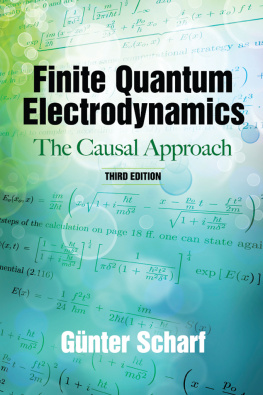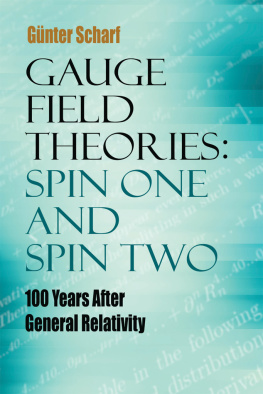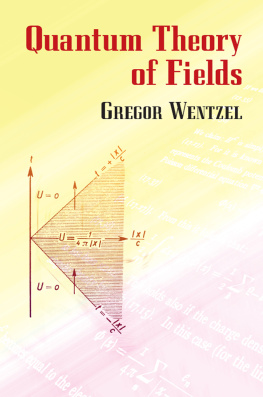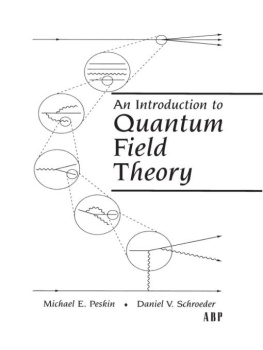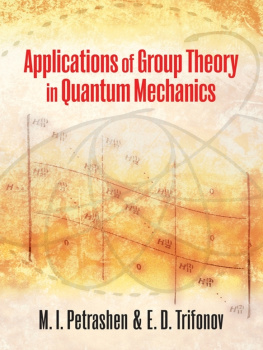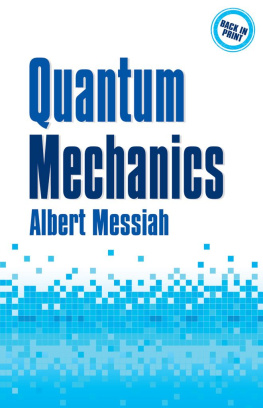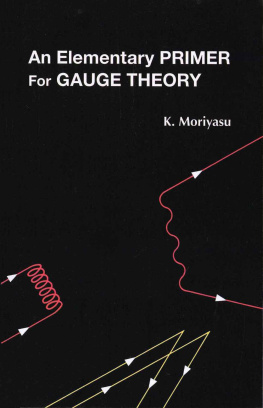Finite Quantum Electrodynamics
The Causal Approach
Third Edition
Gnter Scharf
Department of Physics
University of Zrich
DOVER PUBLICATIONS, INC.
Mineola, New York
Copyright Copyright 1989, 1995, 2014 by Gnter Scharf
All rights reserved.
Bibliographical Note This Dover edition, first published in 2014, is a revised and corrected republication of the second edition of the work, originally published by Springer-Verlag, Berlin and New York, in 1995 [First edition: 1989].
International Standard Book NumberISBN-13: 978-0-486-49273-5ISBN-10: 0-486-49273-7Library of Congress Cataloging in Publication Control Number: 2013040741 Manufactured in the United States by Courier Corporation
49273701 2014
www.doverpublications.com
Preface
Quantum field theory as it is usually formulated is full of problems with ultraviolet and infrared divergences. The former have been taken as an argument to develop radically different theories such as string theory. However, there is a simple way out which one learns in mathematics. One must only adopt the following two rules.
First, use well-defined quantities only, for example free fields. Second, make justified operations only in the calculations; in particular do not multiply certain distributions by discontinuous step functions. If one really follows these rules, then no infinity can appear and life is beautiful. The question then is how to construct the standard theory according to these rules. This one can learn from an old paper by Epstein and Glaser (Annales de lInstitut Poincar A 19, p.211 (1973)). The main tool in this method is causality. The causal method was developed by Stckelberg and Bogoliubov in the 1950s.
One reason for the limited resonance it found was perhaps the highly non-trivial nature of the causality condition. We therefore start slowly. After a chapter on the classical Dirac theory of electrons and positrons and the quantization of free fields, we study the external field problem in some detail. We will find that the (second quantized) scattering matrix (S-matrix) for this problem is uniquely determined up to a phase. This phase contains physical effects, namely the so-called vacuum polarization which is produced by the external field. Therefore, it is needed to complete the construction of the S-matrix, and here is the place where the causality condition comes in for the first time.
With this experience we are then able to construct the S-matrix of full QED by causal perturbation theory in . The important point is that this directly leads to the finite (renormalized) perturbation series. In fact, no divergent Feynman integral and no ultraviolet cutoff will appear in this book, explaining why the title Finite QED was chosen. It is a common belief that QED with a cutoff or scale parameter should be considered as part of a more fundamental theory where the scale parameter disappears, and that the theory is only mathematically well defined in this bigger framework. We will see that there is no scale parameter in QED in the causal approach if the electrons are massive. If one considers massless fermions, then a scale parameter appears in a natural way, because the central splitting solution () which are approximated by perturbation theory.
The fact that the causal theory is perturbative has not only a technical but also a deep physical reason. In any realistic quantum field theory one must draw a sharp distinction between the fundamental fields that appear in the elementary interaction and the asymptotic states describing the real incoming and outgoing particles. This is well known today from the theory of strong interactions (quantum chromodynamics, QCD) where the quark fields are the fundamental Fermi fields, while the mesons and nucleons are complicated bound states of them. But even the electron is complicated because it carries the Coulomb field, so it must be regarded as a bound state where (scalar) photons are confined to a Dirac field. Compositeness is the normal case. Only the photon and the neutrini seem to be elementary in the sense that they can simply be generated by fundamental fields.
In the causal theory the very hard problem of the asymptotic states is clearly separated from the rest of the theory by the method of adiabatic switching: the interaction is multiplied by a test function g(x) and one performs the adiabatic limit g 1 at the very end in observable quantities. This means that the confinement is switched off in the asymptotic region in a gedanken-experiment, so that free fields are coming out, instead of the complicated real physical particles. The switching is then removed in the adiabatic limit. From the study of this limit one can learn something about the structure of the real asymptotic states. It turns out that the limit does not always exist. Only if the right inclusive cross sections are considered does the limit come out finite and unique.
In this way the S-matrix itself dictates the structure of the physical particles, as it must be. This highly important fact, which is even more important in non-abelian theories, can already be seen in perturbation theory, as we will discuss at the end of . But it seems to be rather hopeless to jump by some non-perturbative guess directly to the correct description of the asymptotic states. The inductive construction of the S-matrix enables us to give inductive proofs of the various properties of the theory, in particular gauge invariance and unitarity. These themes are described in we give a short introduction into this fascinating field. A full treatment is given in my book Quantum Gauge Theories - a True Ghost Story Wiley 2001.
In the historical introduction the various lines of development in quantum field theory are discussed. The bibliographical notes give some hints for further reading. Zrich, November 2012 Gnter Scharf
From the Preface to the First Edition
A course on quantum field theory usually starts with classical field theory. Soon the quantization of free fields is discussed. The professor feels happy and the students follow easily. Then comes the moment when interactions are introduced.
If the professor is honest, he then says that he cannot tell what the precise meaning of the interacting fields is. He adds that this question is irrelevant for what follows, because the formulas on the blackboard only serve the purpose of arriving at the perturbation theory. The theory is, so to say, defined perturbatively. He still feels well, the students, however, much less so. The point then arrives when the first non-trivial term of the perturbation series (including non-trivial integration over internal momenta) is calculated and turns out to be infinite. Here a good student protests: Since everything is defined only perturbatively, then nothing has been defined at all ! The professor tries to defend himself: But the theory has to be renormalized, and then the final results are in excellent agreement with experiments.
It would hardly be impolite when the student replies: Are you an experimentalist or a theorist ? Renormalization is indeed necessary, but you must renormalize your style ! This monograph was written to avoid such a disaster. Zrich, 1988 G. Scharf
Contents
0. Preliminaries
We start the numbering with zero because this chapter is preparatory. At the beginning of each chapter we want to make some general introductory remarks because, we think, the reader has a right to know in advance why the material that follows is presented to him. We begin with an introduction into the history of quantum field theory.

